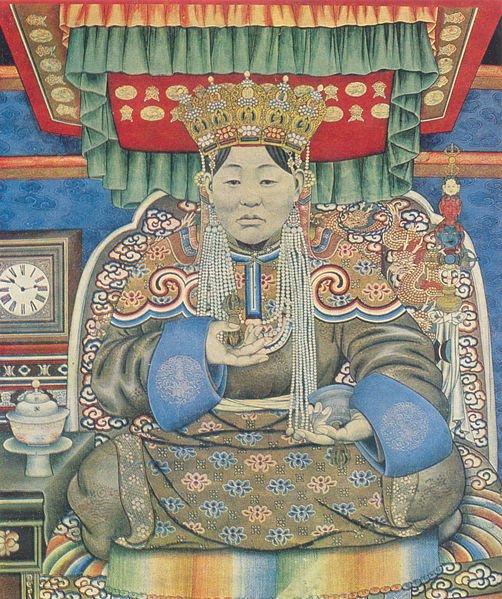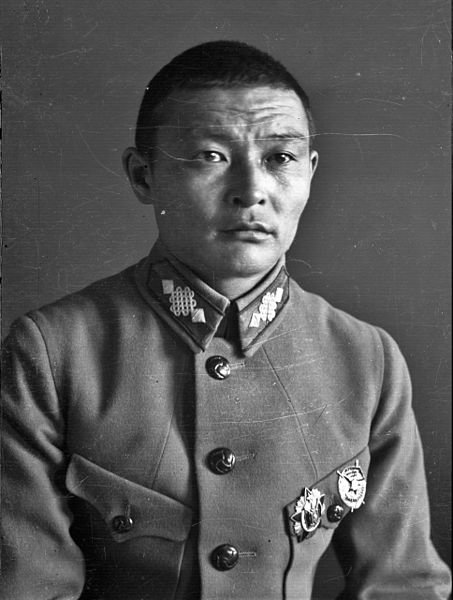History - The End of Mongolian Monarchy And Queen Genepil, Queen Consort of the Last Mongol Khan
Queen Genepil
This history post, about the second wife of the last ruler, or ‘khan’, of Mongolia was the one I’d planned on doing last week.
Not much is known of Genepil, the last khan’s second wife.
I’ll first provide some background about the last khan to, hopefully, help understand her fate.
The last khan was the Bogd Khan of the Bogd Khanate who ruled from 1911 to 1924 after Mongolia declared its independence from the imperial Qing dynasty of China.
This followed the Xinhai Revolution of 1911, which ended that Chinese dynasty and led to the establishment of the Republic of China.
Born in Tibet in 1869, while still a young boy, the future Bogd Khan was recognised as the new incarnation of the ‘Bogd Gegen’, the spiritual leader of Outer Mongolia’s Tibetan Buddhism.
The 3rd most important person in the Tibetan Buddhist hierarchy after the Dalai Lama and the Panchen Lama, he was also known as the ‘Jebtsundamba Khutuktu’; he was the 8th to hold that title.
Taken to Urga (now known as Ulannbaatar), the capital of Mongolia, he spent the rest of his life in Mongolia.
Despite his young age, once he was in Urga, he was subject to the political manoeuvrings of the Qing officials based in Mongolia.
Later, he also had to deal with baseless propaganda attacks of Mongolian communists.
With the Qing dynasty already struggling to reform the Chinese government and resist foreign aggression, Mongol nobles decided the time was ripe to work towards independence.
They persuaded the Jebtsundamba Khutuktu to convene a meeting with nobles and officials to discuss independence.
The start of the Xinhai Revolution on 10th of October 1911 led to the Mongols declaring their independence on the 29th of December 1911.
On that same day, the Jebtsundamba Khutuktu was formally installed as the Bogd Khan, the theocratic sovereign of the new Mongolia.
Bogd Khan, Great Khan of Outer Mongolia (Wikipedia)
By this time, the Bogd Khan was already married with a son.
He’d met his wife, Tsendiin Dondogdulam, in 1895, and they had married in 1902.
Known as the ‘Ekh Dagina’ or ‘Dakini Mother’, she was believed to be a manifestation of White Tara, a highly revered figure in Tibetan Buddhism.
Ikh Dagina Dondogdulam, Queen consort of Mongolia (Wikipedia)
Following custom, she adopted and raised children from families that were unable to care for them.
By the time Dondogdulam died in 1923, aged 47, the Bogd had been removed as the ruler when Chinese troops had re-entered the country in 1919 and occupied it.
In 1921, Mongolia experienced its own revolution, which had been inspired by the Russian Revolution.
Following this, the Bogd, who had been under house arrest, was freed and reinstated but was a ruler in name only.
Ladies at the court of the Bogd Khan (Wikipedia)
Even though the death of his wife had deeply grieved the Bogd, by now an ailing 53-year-old, he felt obliged to take another wife, probably due to the persistence of the court which wanted to maintain the image of the monarchy.
The Bogd’s counsellors had full control over the choice of his new bride, leaving him no say in the process.
The search began in the summer of 1923, and the options were finally narrowed down to girls aged between 18 and 20.
The ‘chosen one’ was 19-year-old Tseyenpil.
Born in 1905, she was the daughter of a noble family in northern Mongolia who lived around the Baldan Bereeven Monastery, one of the largest and most important monasteries in Mongolia.
The fact that she was already married with children wasn’t considered a hindrance as it was common knowledge that being the wife of the khan was purely for the sake of appearance, and the marriage would be a short one.
Taken in the night to the palace, Tseyenpil was only told of her fate when she arrived with the counsellors’ assurance that she would soon be allowed to return to her home as the Bogd was in poor health.
We’ll never know what she really thought of the arrangement; did she formally ask to return to her parents’ home?
If she had, the counsellors would have had no choice but to agree as that was the custom in Mongolia.
Whatever the actual circumstances, Tseyenpil eventually became the Bogd’s wife and queen, and was given the name Genepil.
Queen Genepil
Queen Genepil was queen consort for less than a year.
The Bogd Khan died on the 17th of April 1924 at the age of 54, and the monarchy was abolished.
After his death, Genepil returned to her family, although it is unknown if she returned to her first husband.
However, she wasn’t destined to live out her days in peace.
In the 1930s, for the first and only time in the history of modern Mongolia, total political power was in the hands of one man – Khorloogiin Choibalsan, the leader of Mongolia and Marshal of the Mongolian People’s Army, sometimes referred to as the ‘Stalin of Mongolia’.
Khorloogiin Choibalsan, photo taken around 1925 (Wikipedia)
Between 1937 and 1939, he oversaw the purges in his country, which were an extension of the Stalinist purges occurring in the Soviet Union.
The purges resulted in the deaths of an estimated 30,000 to 35,000 Mongolians, many of them Buddhist clergy, political dissidents, scholars, journalists, ethnic Buryats and Kazakhs, the aristocracy, and those alleged to be “enemies of the revolution”.
Caught up in this was Genepil because of her former status as queen consort.
Accused of working to stage an uprising with the help of Japan, she and her family were arrested in 1937.
There is no evidence to state the accusations were true.
Regardless, Genepil, along with her family, were executed in 1938.
She was only 33 years old.
A tragic end for a young woman who had had no desire to be part of the monarchy.
A little P.S. before I end this post…
If you’re a ‘Star Wars’ fan, the look and style of Genepil and the noble ladies in the images in this post probably look familiar.
Mongolian lady sits for her portrait, 1921 (Luther Anderson, Nat Geo magazine, Wikipedia)
This image of a noble woman, mistakenly said to be Genepil, clearly shows the inspiration for the look of Queen Amidala’s Senate gown in ‘Star Wars: The Phantom Menace’.
Padmé Amidala’s Senate gown in ‘The Phantom Menace’
Even though other traditions and cultures were used as inspiration for Padmé’s other outfits, I like to think this look, which is so different and eye-catching, in a way pays homage to Genepil and those who died in those horrific times.







